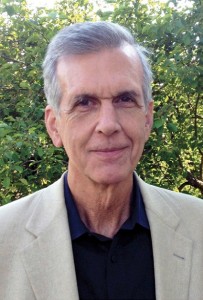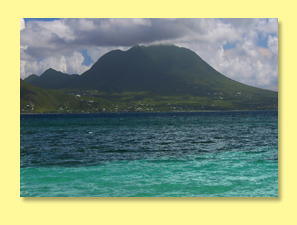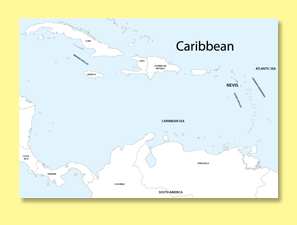The renowned ornithologist/ecologist/biologist, Professor Robert E. Ricklefs, who recently conducted research on Nevis and St. Kitts is made a member of the National Academy of Sciences – a society of the most distinguished scholars in the United States and the world.
Click here to print or download PDF
Profile of Robert E. Ricklefs
In his recent Presidential Address to the American Society of Naturalists(1), ornithologist and ecologist Robert Ricklefs mentioned that for many biologists, the words “naturalist” and “natural history” evoke out-of-fashion 19th century pursuits—an era of pre- occupation with nature before scientists could perform modern investigations of
ecology and evolutionary biology. But Ricklefs, a Curators’ Professor of Biology at the University of Missouri, St. Louis, and recently elected member of the Na- tional Academy of Sciences, takes issue with that evocation, arguing that “natural history observation and thinking are essential to understanding the origin, maintenance, and significance of biodiversity.”
During the month of that address, Ricklefs, Mark Ludlow, and three other ornithologists were traveling by ferry from the Caribbean island of Nevis to their re- search station in St. Kitts, when they spotted an anhinga flying overthe nearby rocks. This cormorant-like bird had never been documented in Nevis before, so the chance observation raised the number of different bird species seen and recorded there to 200. The thrill of such moments has never left Ricklefs, who is now in the fifth decade of his professional career. Such enthusiasm and curiosity have shaped generations of students through his seminal textbooks Ecology (2) and The Economy of Nature (3). He has authored at least two other books, more than 80 articles, and ∼300 papers in peer-reviewed international journals. Through his work, Ricklefs has arguably affected popular culture, as well as scientific thought, in- spiring many to consider humanity’s place in the ecosystem and the connectedness of all living things.
Comfort in Nature
Born in 1943, Ricklefs says he “always felt comfortable in nature.” When he was 9 years old, his family moved to the scenic Monterey Peninsula in California. His father, a lifelong educator, founded a pri- vate college preparatory school for boys. “Naturally, I attended,” Ricklefs says, adding that “the disadvantages of being the headmaster’s son were outweighed by the eclectic faculty that a private and fledgling school could hire. The faculty included retired military officers and graduate students at nearby Hopkins Marine Station.” Ricklefs spent a lot of time outdoors, enjoying camping and fishing trips with his father. “I grew up close to nature—at the end of the street, so to speak, with the woods right out the back door.” The Monterey region features a dramatic meeting of ocean and forest, with huge pine trees, cypresses, and other flora overlooking Pacific wa- ters. When Ricklefs was just 11, a teacher named Margaret Moody introduced him to bird watching. “She took a few students to the mouth of the Carmel River with a spotting scope,” he recalls. “I have never recovered from that experience!” Moody introduced Ricklefs to the local Audubon Society and to curators Merton Hinshaw and later, Vern Yeadon, of the local natural history museum. “I became rather a fanatic, although not exception- ally skilled birder, looking forward to weekend bird trips with the Audubon Society, and enjoying a certain status as a young boy with a serious interest in birds.”
The Pacific coast was a 10-minute walk from his house, so he studied shorebirds and considered becoming a marine bi- ologist. He says, “The legacy of Ed ‘Doc’ Ricketts of John Steinbeck’s Cannery Row was still fresh in the area; the local sar- dine canning industry hadn’t fully col- lapsed yet.” Other influences at this time included a fellow birding classmate, Ar- thur Dahl, and transplanted easterner Laidlaw Williams, who studied the life histories of local birds and whose article in The Condor on the Brewer’s blackbird (4) was already a classic among scholars.
First Exposure to Ecology
Ricklefs entered Stanford University in 1959, shortly after the Russians had sent Sputnik orbiting around the globe. “Students were flocking to engineering and the beginning of the space race,” he recalls. “I was caught up in this craze for a couple of semesters until I realized that I liked biology, and biologists, much more than physics, chemistry, and mathemat- ics.” Botany fascinated him, thanks to two mentors at Stanford: evolutionary biologist Richard Holm and population biologist Paul Ehrlic.
Ricklef’s first exposure to ecology was through a course taught by marine biologist Don Abbott, using Eugene Odum’s textbook Fundamentals of Ecol- ogy (5). “This would have a lasting impact on my career,” Ricklefs says. He fondly remembers his undergraduate years, which preceded the rise of universities as research powerhouses, when access to professors was “truly amazing” by today’s standards.
During his final year at Stanford, Ricklefs asked Ehrlich where he should apply to graduate school. Most biology majors went to medical schools, but Ricklefs desired something different. Ehrlich suggested the University of Pennsylvania (Penn), where ecologist Robert MacArthur taught. “I had not heard of MacArthur, but followed Paul’s advice, was accepted into the graduate program, and headed east to graduate school.” It turned out to be “the most amazing experience.”
Stimulating Conversation, Biogeography
MacArthur, along with colleague E. O. Wilson, had just published their influential article, “An Equilibrium Theory of Insular Zoogeography” (6). The theory held that island fauna existed in equilibrium, with immigration and extinction rates for each species in bal- ance. MacArthur at the time “was play- ing a central role in the resurgence of community ecology and the emerging field of evolutionary ecology,” Ricklefs says. The former is the branch of ecology that studies interactions between and among species. The latter lies at the intersection of ecology and evolutionary biology. It approaches the study of ecology in a way that explicitly considers the evolutionary histories of species and the interactions between them.
Such topics fueled intense lunchtime discussions. Ricklefs looked forward to the stimulating talks with fellow graduate students Mike Rosenzweig, Martin Cody, and Henry Hespenheide. They used to meet daily in MacArthur’s office, where “the conversations were mind-boggling.” A subject that particularly captivated Ricklefs was island biogeography, a field that examines the factors affecting the species richness of isolated natural communities.
Adventures with James Bond
Ricklefs’ graduate years were influenced by the prominent ornithologist James Bond, who worked nearby at the Academy of Natural Sciences in downtown Philadelphia. Bond’s adventures, combined with MacArthur’s interest in island biogeography, encouraged Ricklefs to pursue extensive travel during graduate school. Ricklef’s first voyage took him to the Caribbean to study native birds, a project inspired by MacArthur’s ideas about taxon cycles, drawn from the distributions of Melanesian ants.
Ricklefs spent a summer in Arizona’s Sonoran Desert, where he says that he “stumbled through some projects until fellow birdwatcher Will Russell steered me towards the nesting biology of some of the local birds.” This led to Ricklef’s first journal article, “Brood Reduction in the Curve-Billed Thrasher” (7). Ricklefs recalls the publication with pride. “I became hooked on breeding biology, life histories, and the physiological ecology of desert birds, particularly the cactus wren.” Fellow graduate student Reed Hainsworth, who worked on the neurobiology and physiology of temperature regulation in rats, accompanied Ricklefs in the field the following year.
In 1965, MacArthur moved to Prince- ton University. Ricklefs remained at Penn, and was taken under the wing by avian ethologist W. John Smith. He set Ricklefs up in a postdoctoral year at the Smithsonian Tropical Research Institute, joined by mentors Neal Smith, Stan Rand, and Mike Robinson. “My only other experience in the tropics had been an eye-opening month on Jamaica collecting plants and bird-watching with Hespenheide,” Ricklefs says. “Like many others, I was hooked on the tropics, and diversity has remained a theme in much of my work.”
Smith additionally supported Ricklefs during his transition from the Panama research to becoming an assistant professor at Penn in 1968. Ricklefs later moved to the University of Missouri-St. Louis in 1995 so that his wife, Susanne Renner, and he could have positions in the same department. Renner subsequently moved to the University of Munich, turning the couple into trans-Atlantic commuters and permitting regular contact with European scientists.
Avian Life Histories
From the late 1960s onward, Ricklefs has devoted much of his research to two pri- mary areas. The first is the evolutionary ecology of avian life histories. “I think that my work has contributed to the interpretation of variation in life histories in an evolutionary context, particularly in highlighting the resolution of trade-offs between alternative strategies,” Ricklefs shares.
In particular, he has explored the in- verse relationship between growth rate and the mature functioning of tissues (8). This is particularly evident as a factor in avian growth and development (9). The investigations led to one of the first ex- plicit predictive models of a life-history trait (10). “I have also been fascinated by variation in the rate of embryo de- velopment in birds, which remains an unsolved problem that involves trade-offs between growth rate and individual ‘quality’ and which is manipulated, in part, by the behavior of the parents,” says Ricklef (11). He has additionally written about the connections between early development and aging in this context (12).
Large-Scale Patterns of Biodiversity
His other passion concerned the origin and maintenance of patterns of diversity. Early on, he studied the dynamics of avian distribution and diversity in island archipelagoes, for which he and a colleague developed their own taxon cycle concept based on coevolutionary dynamics of species with antagonists (13). This con- cept lent itself to several papers with El- dredge Bermingham using molecular phylogeography to document the dynamics of colonization and extinction in West Indian birds.
Ricklefs has also been involved in emphasizing the role of large-scale and historical processes in shaping patterns of contemporary diversity from tropical to temperate latitudes. According to Ricklefs, his 1987 article (14) “in a sense legitimized regional/historical thinking in this area after decades of focus on local explanations for diversity patterns.” With a colleague, he later emphasized in multiple papers the diversity anomaly, or differences in diversity between regions with similar environments, between temperate eastern Asia and eastern North America. Through further studies, Ricklefs has emphasized the importance of treating populations, rather than local assemblages of species, as the primary units of community ecology.
In recent years, his focus has shifted to the rapid evolutionary dynamics of host–pathogen interactions, exploring how these factors determine the distributions of populations within regions and influence rates of diversification and the assembly of local communities. In his 2010 Inaugural Article (15), Ricklefs summarized some of his ideas about conceptualizing diversity on a regional basis, particularly considering the large- scale processes that produce regional pools of species, and the ecological interactions that determine their distribution throughout the region and local diversity patterns. The article also dis- cussed the potential role of host–patho- gen interactions in both the diversification of species and their sorting within larger regions. “In this sense,” he says, “the article is largely speculative, but emphasizes an area in which we have very limited knowledge.”
The year 2012 began well for Ricklefs, who published an article (16) that tackled the so-called “neutral theory,” which postulates that stochastic variations in factors—such as the rate of dispersal and extinction of species—determine the patterns of species abundance in different communities. The American ecologist Stephen Hubbell is the leading proponent of neutral theory, which he developed to explain species-rich communities, such as tropical rainforests.
However, Ricklefs disagrees. “There is a very definite process that leads to abundance, and it is deterministic, not random,” he says. “Diversity is a central issue in ecology. Neutral theory predicts that the relative abundance of evolutionary groups should be unpredictable across regions. Looking at large-scale patterns across millions of years of evolution and diversification clearly allows us to reject neutral interpretations.” Or, as his colleague and wife Renner says, “The results can be regarded as a nail in the coffin of the neutral theory.”
Looking Back and Forward
Ricklefs now looks back with amazement on the kaleidoscope of influences and ideas that have shaped his career. “I’m glad that my curiosity about life has not dimmed, and happy to have grown up in natural history and science with encouragement from some absolutely amazing people to think broadly about nature,” he says. In particular, Ricklefs continues to be impressed by the staying power of some of ecology’s persistent questions. What is an ecological community? How do we define a species niche? Why are there so many species in the tropics? What controls the relative abundance of species (17)?
It is difficult for Ricklefs to place a value on explorations that have stirred emotions and inspired countless students over the decades. The introduction to his textbook Ecology, now in its fourth edition, still deeply resonates in his heart: “The natural world is at once orderly and beauti- fully and bewilderingly complex.
Ecologists are drawn to their studies by simple curiosity, which is manifest in endless questions about form and function…We will see that the beauty of the natural world is also an inspiration for ecological study.”
Jennifer Viegas, Freelance Science Writer
1. Ricklefs RE (2012) Naturalists, natural history, and the nature of biological diversity. Am Nat 179:423–435.
2. Ricklefs R (1973) Ecology (Chiron, Portland, OR).
3. Ricklefs R (1976) The Economy of Nature (Chiron, Portland, OR).
4. Williams L (1952) Breeding behavior of the Brewer’s blackbird. Condor 54:3–47.
5. Odum E (1953) Fundamentals of Ecology (Brooks Cole, Stamford, CT).
6. MacArthur R, Wilson E (1963) An equilibrium theory ofinsular zoogeography. Evolution 17(Issue 4):373–387.
7. Ricklefs R (1965) Brood reduction in the curve-billed thrasher. Condor 67:505–510.
8. Ricklefs RE (1979) Adaptation, constraint, and com-promise in avian postnatal development. Biol Rev Camb Philos Soc 54:269–290.
9. Ricklefs R, Shea R, Choi I (1994) Inverse relationship between functional maturity and exponential growth rate of avian skeletal muscle: A constraint on evolutionary response. Evolution 48:1080–1088.
10. Ricklefs R (1984) The optimization of growth rate in altricial birds. Ecology 65:1602–1616.
11. Ricklefs R (1993) Sibling competition, hatching asyn- chrony, incubation period and lifespan in altricial birds. Curr Ornithol 11:199–276.
12. Ricklefs RE (1998) Evolutionary theories of aging: Confirmation of a fundamental prediction, with im- plications for the genetic basis and evolution of life span. Am Nat 152:24–44.
13. Ricklefs R, Cox G (1972) Taxon cycles and the West Indian avifauna. Am Nat 106:195–219.
14. Ricklefs RE (1987) Community diversity: Relative roles of local and regional processes. Science 235: 167–171.
15. Ricklefs RE (2010) Evolutionary diversification, co- evolution between populations and their antagonists, and the filling of niche space. Proc Natl Acad Sci USA 107:1265–1272.
16. Ricklefs R, Renner S (2012) Global correlations in tropical tree species richness and abundance reject neutrality. Science 337:464–467.
17. Ricklefs R (2011) A biogeographical perspective on ecological systems: Some personal reflections. J Biogeogr 38:2045–2056.
This is a Profile of a recently elected member of the National Academy of Sciences to accompany the member’s Inaugural Article on page 1265 in issue 4 of volume 107.






